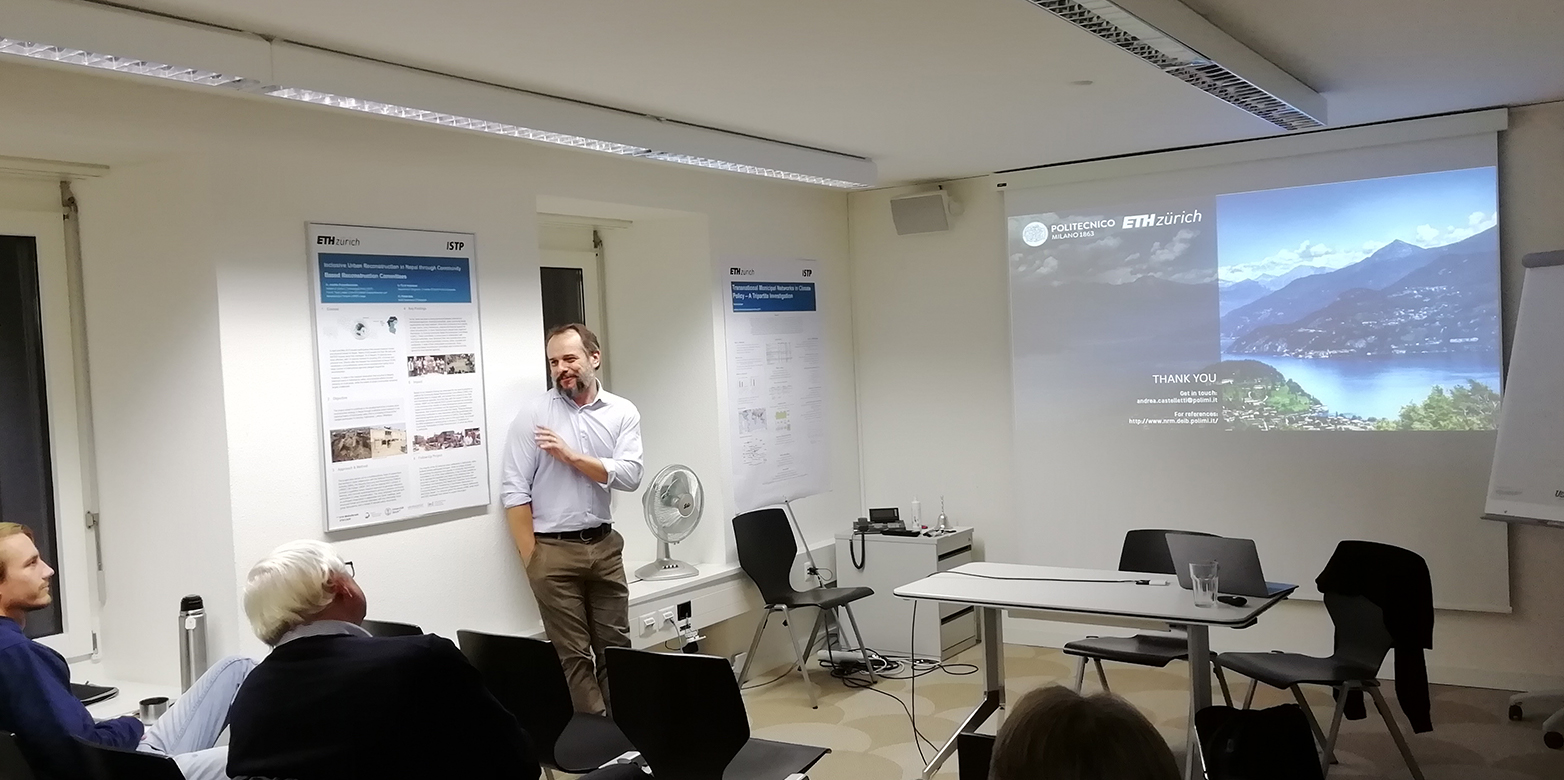Soft-path solutions for hard water problems
Prof. Andrea Castelletti from the Natural Resources Management Group at Politecnico di Milano visited the ISTP to give a talk on soft-path solutions for hard water problems in the Italian sub-alpine lake district.
by Evelyne Vonwyl

One of the main research areas of the Natural Resources Management Group is the Italian sub-alpine lake district including the following six lakes: Lago di Lugano, Lago di Maggiore, Lago di Como, Lago d’Iseo, Lago d’Idro, and Lago di Garda. In the past, the sub-alpine lake district used to be a complex network of cannels and rivers that was naturally regulated. In the beginning of the 20th century, artificial regulations of the flows were introduced. Today, these water system areas are highly coupled human and natural systems. Having multiple users they are subjected to conflicts of interest.
Prof. Castelletti continued his talk by focusing on one of the 6 lakes, Lago di Como with a watershed of 4500km2. The lake has different users, including an upstream hydropower region with 16 plants, an environmental area on the northern shore of the lake, and farmers downstream of the lake, using the water for irrigation. The water authority of the lake has to balance the system. At the same time it has to provide sufficient water to all its users and to prevent flooding.
One of the raising challenges is climate change. Historical data from the past, starting in 1946, show a shift in the water level of the lake. The number of dry summer years is increasing. Models indicate that in the far future, when ice melting of the glaciers slowly decreases, there will be a large reduction in water availability.
Next to climate change, also socio-economic changes will increase the conflict in the area of Lago di Como. There is a steady increase in energy demand and renewable energies. Thus, there is an increasing interest in Alpine hydropower. “Shrinking the pie and making the conflict harsher”, said Prof. Castelletti and emphasized that compromising solutions are getting more difficult.
To cope with these emerging problems, he proposed a soft-path approach. He suggested to rather deal with the existing infrastructure than doing large investments to build new ones. The overall productivity shall be improved by making the water availability more efficient.
Better informed decisions are one of this soft-path approaches. Towards pervasive sensing of the water cycle, the reservoirs need to be known. Next to the observed water level of the lake, there are other reservoirs that should be accounted. Information on the soil moisture content, upstream snow pack and reservoirs, and the ground water content could support decision-making processes.
Prof. Castelletti presented a framework to support information selection developed by his group. The ideal operation is computed to minimize the water deficit and at the same time, minimize the flood risk. Depending on how much information on the water cycle of Lago di Como can be fed into the calculations, the model can be optimized.
He concluded this section of the talk by emphasizing the need to consider low-cost type of options prior to any hard path by better understanding how decisions use information. Valuable forecast will play a key role in the future.
In the second part of the talk, the approach of better coordinated decisions was discussed. River basin systems are often prone to power asymmetry leading to inefficient and unbalanced water allocations. On the example of Lago di Como, Prof. Castelletti illustrates the disparities of the downstream farmers using the water to irrigate their crops and the upstream powerplants trapping the snowmelt volume. While the water authority could force the powerplants to release water to minimize irrigation deficit, an insurance tool is proposed to coordinate the different needs of the actors in order to increase acceptability. The revenue shall be maximized whereas the irrigation deficit is minimized. An index-based insurance may offer a reliable and relatively inexpensive alternative to other forms of water managements.
In the last part, Prof. Castelletti talked about behavioral uncertainty and the difficulty to project human decisions. He projected the water level of Lago di Como from the mid of the last century to today. From the course of the data it became clear that the lake level was associated with the decision of the lake operator. Due to several flood events in the past, the risk attitude of the lake operator has changed.
In the final Q&A session, the insurance tool was further discussed. The question on the acceptability of the tool by different actors was raised. Moreover, the implementation of this insurance tool in developing countries was discussed.
We would like to thank Prof. Castelletti for his interesting talk and the visit at the ISTP.
To get a broadened sense of the ISTP and our topics of interest and past seminars visit our Colloquium page.